[At the risk of boring you to death, I'm going to resume my Micronesia notes. The slide projector humming in the airless gloomy room…]
On our first full day in Pohnpei, we took a tour to these Micronesian ruins called Nan Midol. I'd never heard of them before, not surprising that I'd never heard of Pohnpei. It was a fun day; we went by boat, a smallish motor boat with about seven of us guests, a Pohnpeian man called Bidi at the dual outboard motors, and a Japanese man called Tomo doing the guiding.
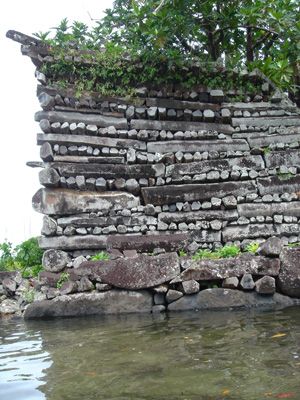
First we stopped at a tiny sandbar with a couple of trees on it and went snorkeling. Ah, those fish of the Micronesia. There's one amazing largish fish called the diagonal-barred sweetlips, it's pale yellow with dark stripes on it which break into dots near its belly. This is precisely a reaction-diffusion pattern that I've created many times with my cellular automata using a rule devised by Alan Turing. Computation everywhere. Embry found a little pipefish, which looks like a seahorse without the wings. A bumpy long segmented body and a little horse head, the fish only a few inches long, nosing around in a little algae-grown bowl of coral. I'm particularly fond of some small bluish-green fish that are found schooling in the stag-horn coral, iridescent really, their exact color depends on the light, often they're a pale turquoise like shallow water above sand, other times they're like a tint of the sky, and sometimes they seem to glow as if they're electric. It truly is as if you're swimming around inside the most lavish possible imaginable pet-shop aquarium. But it goes on as far as you can see in every direction, and the currents are flowing through. The coral comes in a wonderful range of shades. There are some rounded heads that are truly that tacky orangish-pink “coral” color beloved by mail-order catalogs, but there's also delicious pale mauve tones. The staghorn corals have amazing lavender tips.
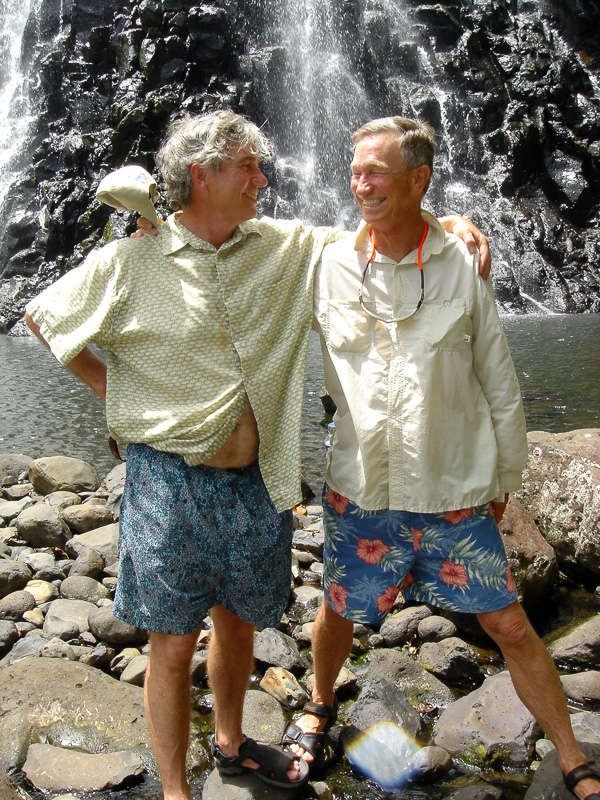
Second we pulled into a Stone Age wharf of, yes, stones, a few shacks of corrugated tin nearby. Debarked and walked up a trail along a stream to a tropical waterfall, white rivulets splashing down a bumpy fifty-foot slope of the smooth dense volcanic rock called basalt. I jumped into the pool, about ten feet deep, and swam around. At first I was the only one swimming. I looked over at our guide Tomo on the shore, and he was making swimming motions with one hand, and then holding his hands very far apart. Big fish? I opened my eyes underwater and saw some medium sized brown fish. Embry beckoned me towards the shore, Tomo had thrown in some bread crumbs, and there eating them was a fresh-water eel four feet long, a really fat guy, with alarming sharp dog-like teeth. I wondered whether it would be wise to touch his tail, I was standing in the water about a foot away from him. “Electric?” I asked Tomo. “I don't think so,” he said. And then the eel swam back into the deep water, not quite touching me. On the walk back down to the boat, Tomo told me that that for the Pohnpeians, an eel is, “Halfway between man and god. Or for some people maybe like a pet. They don't eat eel, but they eat dogs. Dogs not a pet on Pohnpei.” Later, Patti the inn-keeper told me that for kids in Pohnpei the dogs are like pets, and they're often heart-broken when the father of the family decides to butcher Fido for a feast, it's a common trauma. Speaking of dogs, there's two taciturn resident mutts at the Village. As I was moving into my room, they came and slept on my deck for an hour. “A sign of acceptance,” said Patti.

Third we stopped on a small island called Na for lunch. Small island, small name. It was covered with jungle, fairly open, so that you could walk the few hundred feet to the other side. The coconut trees had notches on them, and a lot of husks lay about, apparently the locals come here to harvest the nuts. In the Village restaurant you can get a fresh coconut to drink for a dollar, they chop off the top and stick in a straw, it's slightly sweet, slightly bubbly, fresh and wonderful-tasting. Embry and I had learned by now to usually order “bento” instead of “sandwich” for lunch. Our bentos were wads of rice with grilled tuna and some boiled vegetables, each lunch squeezed into a clever wrapping of banana leaf. This green, conical ice-cream-cone like leaf pack with a flap of leaf folded over; you unwrap it and eat it with chopsticks.
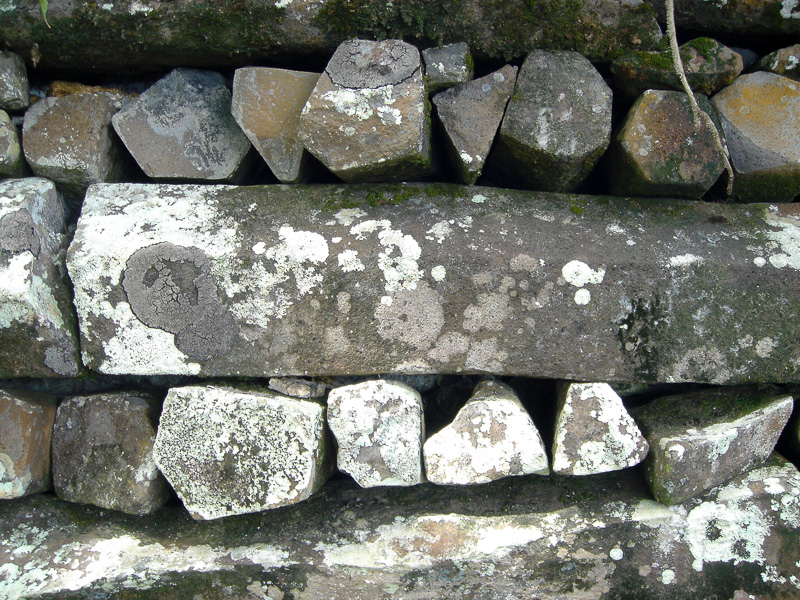
Fourth we reached Nan Midol. This was the home base and capital of the Saudeleurs, a Micronesian group of warriors who ruled Pohnpei from about 500 AD to 1500 AD. Rather than being on land, Nan Midol is a collection of about twenty little artificial islands created by making walls of basalt and filling them in with coral. And sitting on the islands are more structures of basalt megaliths. It's a little Venice.
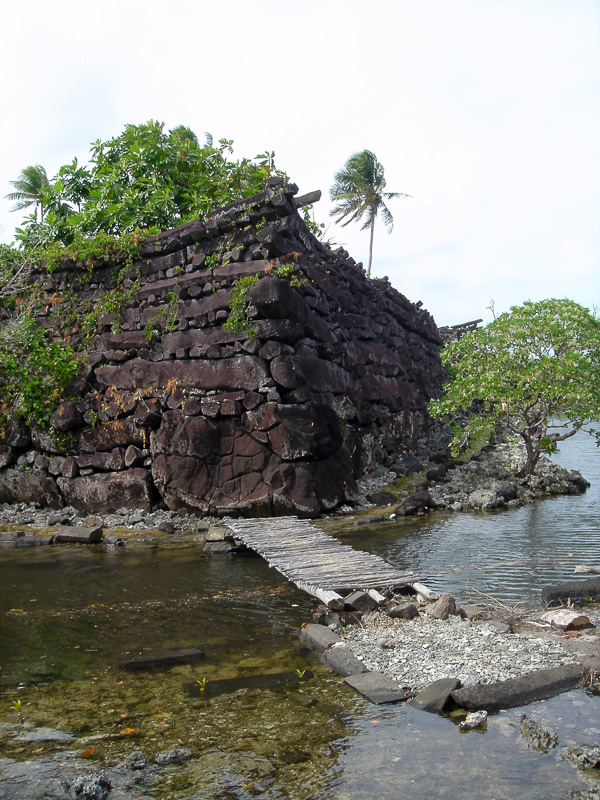
There's this odd feature of volcanic basalt, which is that if it cools slowly, as in the plug of a volcano, it forms long vertical crystals. Technically speaking, these are what chaoticians call Benard convection cells, akin to the networks you see sometimes in the mist on water in the morning, also akin to the depressions found in the sand on a beach. The famous Devil's Tower of South Dakota is a huge bundle of these basaltic frozen Benard convection cells. And Pohnpei has two natural towers like this: one is called Sokehs Rock, the other is called, believe it or not, Chickenshit Mountain (supposedly a mythic rooster dropped this one). If you quarry a big chunk of the basalt from these plugs and heat it over a fire, it quite naturally breaks into log-sized chunks, often hexagonal or pentagonal in cross-sections, but sometimes with triangular or square cross-sections as well. And the “rock logs” can be six or even twelve feet long.
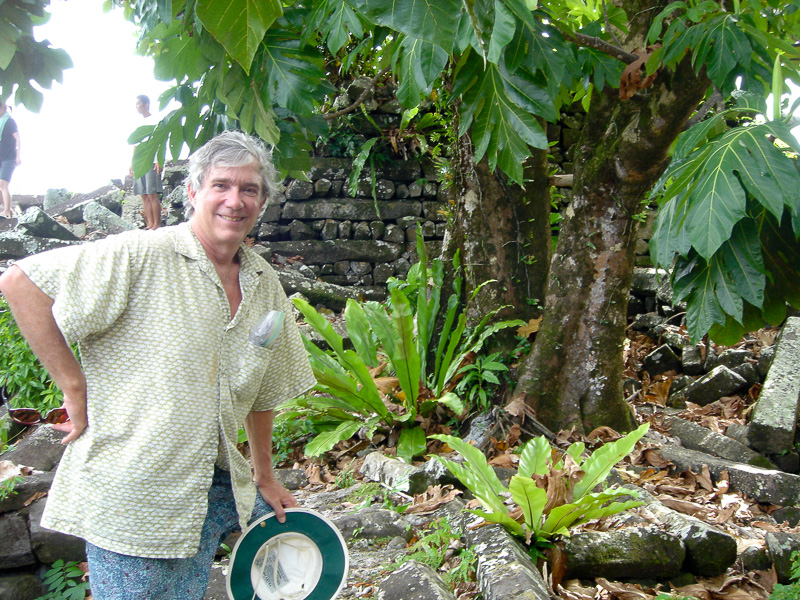
So what the Saudeleurs did for their little city was to float the rock logs, the megaliths, down on bamboo rafts — there's a good current that makes this pretty easy — and then they piled up the rock logs to make structures a bit like log cabins — which must have been hard, maybe they used coral ramps to get the logs up high. Being South Pacific islanders, they didn't make solemn Lincoln-log squares of their walls, no, they bowed them in a bit, and ran them up to jutting pagoda-like points at the corners. Think Tiki Bar.
The boat pulled into one of the old canals, and we got out onto some stone steps, paid a minion of the unseen chief $3 a head, and looked around, nobody else there but our party of seven tourists and two guides.
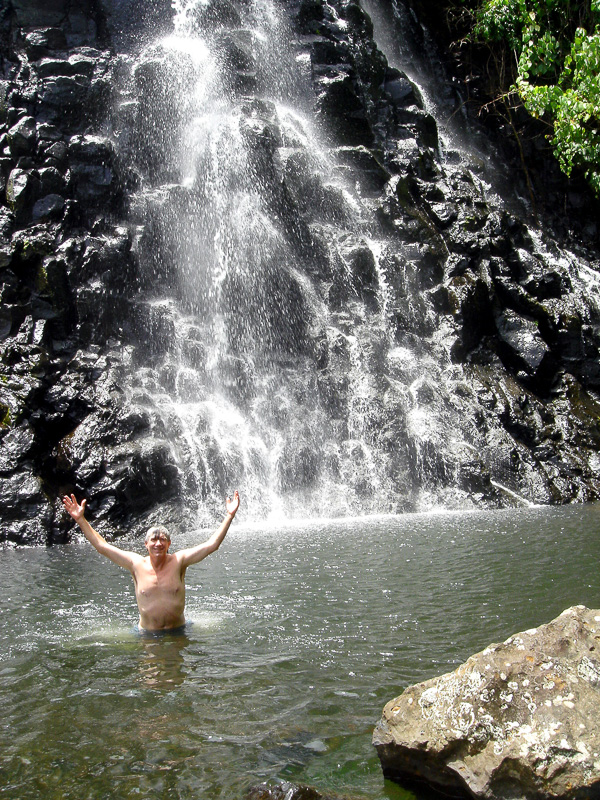
Ah, the romance of stone ruins amidst jungle plants. Breadfruit trees with great oaky leaves were knotting their roots into the ruins, the great oval green breadfruits swaying in the trade winds. I thought of the Greeks, the Romans, the Mayans. Everything was pristine and natural, no trash in sight, no signs, nothing but the ruins, the jungle, the rising tide of the sea, and the single uncommunicative minion of the Micronesian king.








